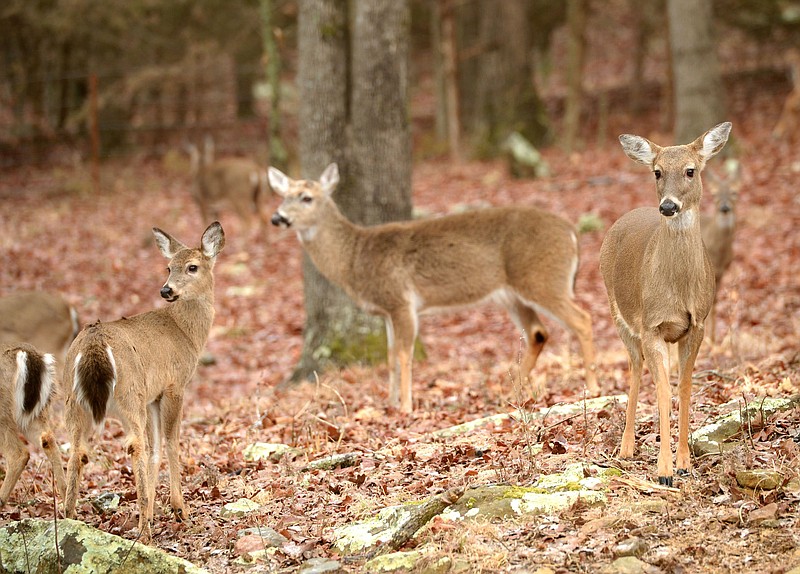Although Arkansas is mostly rural, we have the same problems with overpopulation of deer that some major cities experience.
To alleviate those problems, Bull Shoals, Cherokee Village, Fairfield Bay, Heber Springs, Helena/West Helena, Horseshoe Bend, Hot Springs Village, Lakeview and Russellville hold controlled, archery-only hunts within their incorporated limits.
The hunts will begin Sept. 1 and are conducted in partnership among the Arkansas Game and Fish Commission, the Arkansas Bowhunters Association and the Bull Shoals and Lakeview Urban Bowhunters Association. Ralph Meeker, deer program coordinator for the Arkansas Game and Fish Commission, said the partnership with the two bowhunting associations helps ensure that participating hunters are proficient and guides hunters on how to be discreet and understand the nuances of hunting in an urban setting.
"All hunters must pass a proficiency test, pass the International Bowhunters Education Program (IBEP) course, and attend an orientation before receiving their urban hunt tags," Meeker said. "The training is not difficult, but it does ensure that participants are capable of making ethical choices and a clean harvest."
According to State Farm Insurance, Arkansas ranks high in deer-vehicle collisions. The ornamental gardens, golf courses and green spaces in retirement communities such as Fairfield Bay, Hot Springs Village and Cherokee Village comprise ideal habitat where deer can live their entire lives in virtual solitude. In communities that hold urban hunts, bowhunters help reduce deer to more tolerable numbers.
Mike Stanley of Highland is an avid bowhunter who has participated in the Cherokee Village urban bowhunt from its beginning. He has also participated in the urban bowhunts at Horseshoe Bend. He said the hunts provide a lot of hunting opportunity before the statewide archery season opens in areas that don't see a lot of hunting pressure. The main reason he likes them is because the hunts accomplish their purpose. Also, reducing competition for forage improves the health of the remaining deer.
"One thing that's noticeable to me, and others have told me this in Cherokee Village and Horseshoe Bend, that these urban hunts are producing a lot healthier deer than what was in these places before urban hunts," Stanley said. "Deer are healthier body-wise because they not as overpopulated. We don't see the big herds anymore like we used to, but the ones we do see are healthier."
Stanley said the communities thoroughly vet applicants before awarding permits. That helps ensure safety and good public relations. The vetting process weeds out unethical hunters, and those who might be inclined to bend or skirt the rules. For example, applicants for the Cherokee Village hunt cannot have any serious hunting violations on their records. They are also required to pass the International Bowhunter Education Course, and they must attend a field exercise to demonstrate they are proficient with their bows. That entails putting three arrows into the kill zone of a target at 20 yards.
"When I took mine, they really drilled us in basic safety, ethics and common sense type stuff," Stanley said.
Hunters must find their own places to hunt. That requires making new contacts and tapping existing contacts. Some hunters contact local leaders to find landowners that have reported problems with deer.
There are hundreds of acres in Cherokee Village, Horseshoe Bend and Hot Springs that don't have dwellings or people living nearby. Even so, hunters must understand that people can show up anywhere, anytime. Someone walking a dog past your stand certainly complicates a hunt, but participants understand that crowd participation comes with these peculiar venues.
Scouting urban areas is also a challenge. The weather is hot in early September. The trees are in full foliage and haven't started dropping acorns yet. Deer haven't started their fall travel and feeding patterns.
"I approach it like I approach hunting public land," Stanley said. "I want to familiarize myself with the area as much as possible. I look for terrain features, like gullies and draws that deer like to travel through. People don't build houses in gullies and draws, so I concentrate on those."
Like public land, neighborhood hunting areas can change from year to year. Somebody might build a new home in a former hot spot, or a bad storm can ruin an area.
Overall, the hunting has also gotten more difficult than it was in the early years. There aren't as many deer as there were 15-20 years ago, and deer have adjusted to the pressure.
"Anyone that thinks urban deer are dumb deer are sadly mistaken," Stanley said. "They wise up."
Stanley says he considers killing deer in the urban hunts a public service.
"Highway 175 goes through the middle of Cherokee Village," Stanley said. "Every time I take one out, that's one more that won't be running out in front of somebody."
Deer killed during urban hunts do not count toward a hunter's seasonal limit. Hunters may take an unlimited number of deer, and there are no antler restrictions. They must also donate the first adult deer they kill to Arkansas Hunters Feeding the Hungry.
For more information, visit www.agfc.com/en/hunting/big-game/deer/special-hunt-permits/urban-archery-hunt. Additional details are available at www.arkansasbowhunters.org.
